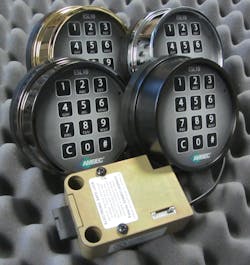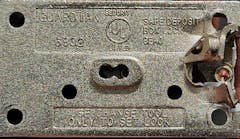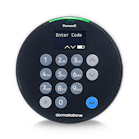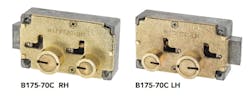As technology advances and new laws and policies stress the importance of secure record storage with audit trails, safe and safe lock manufacturers are migrating to electronic safe locks.
The GSA (General Services Administration) continues to increase the level of security for FF-L-2740 applications. Companies are becoming less dependent upon employee honesty and moving towards access that is more limited to cash, credit card and personal records. Simply stated, the idea of security and safety is evolving to very different levels.
Although the venerable mechanical safe lock has made some inroads, it is limited by design. Mechanical locks require prior knowledge. Not only for the combination itself, but the operator must know the dial rotation directions. Good eyesight and lighting are necessary to accurately dial the combination. For most people, operating a mechanical combination lock necessitates a fair amount of patience and practice. To complicate matters, some mechanical safe locks do not dial open in the same way.
Electronic safe locks are becoming the more popular choice for both residential and commercial applications because they provide greater functionality and ease of use. Residential electronic safe locks can meet the needs of elderly, disabled and the impatient, which probably includes the majority of people.
For commercial, institutional and government requirements, electronic safe locks offer advanced security features including biometrics, multiple users with unique security privileges, time lock, time delay, programmable events and one-time use combinations. To ensure higher levels of performance, electronic safe lock manufacturers test lock performance to meet requirements including stress, vibration, shock, electrical discharge and electromagnetic pulse. An Underwriters Laboratories Type 1 Listing certifies that the lock meets the appropriate standards of security and construction.
Electronic safe locks and redundant safe locks provide your customers with a variety of feature and functionality. Talk with your customers to determine what their exact requirements and cost constraints are. An electronic safe lock is not much more expensive than a mechanical safe lock.
Basic electronic safe locks provide the average safe owner with the ability to keep the unauthorized from gaining access. To gain access, the user enters the six-character combination (code). There is no dead zone in an electronic safe lock, enabling the end-user to choose from up to 1 million different combinations in a single user, with no service code. Combination changes and programming are made at the keypad or, if connected to a PC, using the software.
Many keypad-equipped electronic safes have a telephone style button layout for ease of use. Variations may include four buttons in a row, three rows tall. Most electronic safe locks provide visual and audible feedback when operating the lock mechanism. For protection, most electronic safe locks have a wrong combination try penalty. Many meet UL Type 1 requirements.
Unlike a mechanical safe lock, an electronic safe lock may not require a mechanical spindle to operate. This permits the lock to be located away from the spindle opening in the door. However, safe manufacturers would have to relocate the lock mounting, the safe boltwork and hardplate locations. Having multiple locations would increase security, as there would be more than one drill point for each possible entry method. Another difference is there are no contact points, reducing the methods to manipulate open an electronic safe lock.
Many electronic safe lock bodies have the same mounting footprint as standard mechanical safe locks, allowing for easy retrofit without modification. Electronic safe locks have no wheels; they are universal for RH (Right Hand), LH (Left Hand), VU (Vertically Up) and VD (Vertically Down) mounting. However, electronic safe lock body thicknesses vary by design and are sometimes different from the thicknesses of the mechanical safe lock being replaced. Some secondary mechanisms (i.e. relocks) in safes may require modification to accommodate the smaller body thickness of an electronic safe lock.
Input devices (keypads, etc.) are installed using the same mounting holes as standard mechanical dials. The wiring is run through the standard ½" spindle hole to the lock so no additional holes have to be drilled.
When an electronic safe lock is in the locked condition, the bolt of the safe lock obstructs the opening of the safe door. When the correct combination is dialed or entered, the bolt retracts or swings, permitting the opening of the safe door.
Swing, Slam & Square Bolt
Three basic styles of electronic safe locks can be used to replace a mechanical safe lock: the electronic swing bolt, slam bolt and square bolt lock (named by the author to simplify writing of this article). The type of bolt is determined by the safe’s locking mechanism.
Approximately 75 percent of the safes worldwide being equipped with electronic safe locks use swing bolt safe locks. Approximately 25percent use electronic square bolt safe locks. Slam bolt style electronic safe locks are used about 2 percent of the time.
The swing bolt electronic lock is designed for safes that do not require rotation through the spindle hole. When powered by entering the correct combination/code, the swing bolt incorporates a solenoid or motor that retracts it into the lock case or removes the obstruction enabling the swing bolt to pivot out of the way as the boltwork slides. When the swing bolt is pivoted or the obstruction is removed, the safe can be opened. The swing bolt design name varies by lock manufacturer. It is also known as RotoBolt, Rotary Bolt, Pivot Bolt, etc.
When unlocked, the bolt pivots out of the way of the boltwork. The boltwork moves to the unlocked position. The swing bolt will remain retracted until the boltwork returns to the locked position, enabling the swing bolt to extend (into the cutout) and lock. The solenoid is spring-loaded waiting until it aligns with the cutout in the locked position to engage. The swing bolt is deadlocking. It has a deadlatch that does not allow the bolt to be retracted when in the locked condition.
LpLOCKS has introduced the NL Universal RotoBolt Lock. This patented U.L. Type 1/VdS Klasse 2, a six-digit changeable code electronic safe lock that is half the size of a standard electronic safe lock and does not cover any portion of the spindle hole. If a person attempts to punch the lock through the spindle hole, the Universal RotoBolt Lock will not be contacted.
This one user code (and Service Code) lock is paired with the top lit, Premier Basic Keypad, equipped with a 12-button Mylar, angled front reading keypad. The bright chrome finish keypad provides audible and visual feedback.
The slam bolt electronic safe lock, also known as a direct locking lock, is a non-deadlatching style safe lock. It has a spring-loaded latch, securing locker application safe doors, interior safe doors and cabinet doors where boltwork is not present. When the proper combination is entered, a motor or solenoid retracts the bolt, permitting the door to swing open. The slam bolt extends after the programmed retraction time. As the door is being closed, the slam bolt contacts a strike or ramp mechanism and retracts. Once the door is closed, the slam bolt extends, securing the safe door.
There are other versions of the locker application electronic safe lock. Before purchasing this style of safe lock, check with the safe manufacturer to be certain the lock is compatible. The slam bolt design name varies by lock manufacturer. It is also known as the spring bolt, non-deadlocking spring bolt, etc.
The square bolt electronic lock has a rectangular bolt that obstructs the movement of the boltwork. The square bolt electronic lock can function as an automatic actuation lock using a motor or solenoid, or a manually driven lock using a component of the input device that retracts the rectangular bolt. When an electronic square bolt safe lock unlocks, the bolt must retract in order to allow the boltwork to pass and open the safe. Most locks that block boltwork mechanism cannot be pushed back in the locked condition. The square bolt design name varies by lock manufacturer. It is also known as the straight bolt, deadbolt, etc.
Note: Because of the number of electronic safe lock manufacturers and the applications, the above bolt style information should be considered a guideline only.
Most electronic safe locks have the logic, memory and functionality built into the lock case. The input device is then mated with the lock to be able to perform the different electronic and, if equipped, mechanical functions. Some import electronic safe locks have the logic and memory built into the keypad. This configuration can result in someone tampering and gaining unauthorized access.
Input devices for electronic safe locks come in a variety of styles. The most common are the 12-button keypad style. An example is the AMSEC ESL10XL is a 12-button telephone style keypad. Depending upon the manufacturer and model, they can be constructed of molded plastics, cast metal or stainless steel.
To provide greater functionality, keypads/input devices can have additional components. For example, the Sargent and Greenleaf Biometric Keypad has a 12-button telephone style keypad with a display and a silicon-based active capacitive fingerprint reader. The AMSEC ESLAudit Lock keypad has additional buttons on the keypad. The Securam ScanLogic Series Keypad has a biometric reader, LCD Screen and 14-button keypad. Some keypads are available with backlighting or top lighting. The Securam SafeLogic BackLit has a backlit entrypad to illuminate the buttons in a dimly lit area.
There can be more than one 9Volt battery powering the keypad/input device and safe lock. For most electronic safe locks, the batteries are located within the input device. This makes it easier to replace the batteries.
Aftermarket electronic safe locks can be sold in two ways: first, as two components/part numbers, the input device and the lock, and second, as a kit/package with one part number.
Choosing an electronic safe lock and input device is determined by the functionality. For example, the basic electronic safe lock with keypad can have as few as one six-digit code/combination and a usually a Service Code (this is normally referred to as the Manager Code). The service code is normally not mentioned as it is used by the safe manufacturer to unlock the safe when a customer no longer has access to their code. Other basic models offer two or more six-digit user codes, combining a master, manager, supervisor or other higher level code with at least one user code. The user code can only unlock the lock. The higher level code can add/delete or enable/disable the user code and in most applications unlock the lock.
Most electronic safe locks include a five- to 15-minute penalty lock out upon entry of four incorrect codes. Some electronic safe locks can have a reset function that returns the lock to factory default settings and codes. Changing the code is the only programming feature in a basic electronic safe lock.
Examples of residential application U.L. Listed Type 1 electronic keypads and locks are the AMSEC ESL5, LA GARD Basic Series, LpLOCKS NL Universal RotoBolt Lock and standard RotoBolt, Sargent and Greenleaf Spartan and Securam SafeLogic BackLit. These safe lock examples can have up to two user codes. Depending upon the manufacturer, these locks may be available with a square bolt, swing bolt or slam bolt. AMSEC offers the ESL5LP, residential application electronic safe lock with the handle built into the keypad housing.
Going beyond the basic, commercial electronic safe locks features and functionality can include multiple users, single/dual control, time delay, time lock, duress, alarm interface, etc. For example, the Securam ProLogic L02 is designed for a one-door safe. The ProLogic L02 offers 30 user codes, single or dual control and Time Delay. The LpLOCKS multiple user lock has nine Users, single or dual control, Time Delay and duress.
An audit lock is a commercial electronic safe lock that has multi-level users, audit trail with time and date stamp and other features to increase the level of accountability. Most audit locks operate with a computer interface. The AMSEC ESLAudit Lock is designed for one- or two-door safes. Standard features include 40 users with unique security privileges and authority levels, 2,000 audit records, USB interface, time delay, time lock, PIN code and/or Dallas Key, holiday scheduling and graphics display.
Specialized electronic safe locks include biometric locks with fingerprint readers, redundant locks and GSA approved locks.
Redundant Safe Locks
A redundant safe lock is a mechanical lock that has electronics either piggybacked onto or built into the case. The redundant lock can be operated as an electronic safe lock by entering the code into a keypad/input device or as a mechanical lock by dialing the combination. A redundant safe lock can be operated by a single input device equipped with an electronic keypad and a mechanical dial or a keypad and a mechanical dial.
The Kaba Mas X-0 series meets Federal Specification FF-L-2740 requirements, the U.S. government’s highest security standard for electro-mechanical locks. The X-10 is the latest edition, approved for FF-L-2740, latest revision B, Style 1 applications. The X-10 is approved by the GSA for use on approved Class 5 and 6 filing cabinets and Class 5 Security vault doors.
For specialized applications, the use of redundant locks may provide an alternative. Many high level jewelry safes have two mechanical locks to provide a high level of protection while simplifying the opening procedure. A double bitted key-operated safe lock provides the day lock and a Group 1R mechanical combination lock is for the night lock. Upon entering, the jeweler unlocks the mechanical combination lock, leaving the safe secured with the key lock. When a customer wants to view an expensive piece of jewelry, the jeweler unlocks the key lock, removes the item and relocks the key lock, securing the safe. To return the piece, the jeweler uses the key again. At the end of the day, the jeweler locks both the mechanical combination lock and the key lock. Dialing a combination every time a customer wanted to see an expensive piece of jewelry and again to return it to the safe would be very time-consuming.
The redundant safe locks offers similar protection and safety for a jewelry safe by having two different methods of entry. The combination satisfies the day lock requirements by providing easy access to employees while the shop is open for business but allowing the owner to secure the safe in off-hours, preventing employee theft.
A redundant safe lock can greatly reduce the worry about a safe lock failing. If one lock failed, the safe could still be opened by operating the second lock, with no need to drill the safe.
Redundant mechanical locks are available from LA GARD (2441/6441 Electronic and 4-Wheel Group 1 Locks), Lock DUO* sold by Lockmasters and the Securam SafeLogic Xtreme*. LPLOCKS also offers the redundant lock designed by NL. LpLOCKS will be introducing a RotoBolt redundant lock that is UL Listed Type 1 and VdS classified during the summer of 2015.
*The Lock DUO and the Securam SafeLogic Xtreme are designed for safes equipped with only one spindle hole.
Another consideration for the redundant lock is potential failure of the electronics due to ElectroMagnetic Pulses (EMP). A strong EMP can render electronic systems inoperable. When a safe is equipped with a redundant lock, no matter the effect on the electronic components of the safe lock, the mechanical combination can always be dialed to open the safe.
Sargent and Greenleaf recently introduced the EMP-Resistant electronic combination safe lock that has passed the MIL-STD-461F (50 kV/m Blast) test from the Department of Defense Interface Standard. SecuRam also offers EMP-resistant locks.
For more information, contact the following safe lock manufacturers:
- AMSEC: www.amsecusa.com
- Kaba Mas: www.kaba-mas.com
- LA GARD: www.kaba-mas.com
- LpLOCKS: www.lplocks.com
- Millennium Locks Corporation: www.milocor.com
- Sargent and Greenleaf: www.sargentandgreenleaf.com
- Securam: www.securamsys.com






